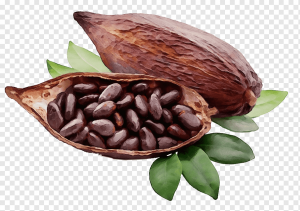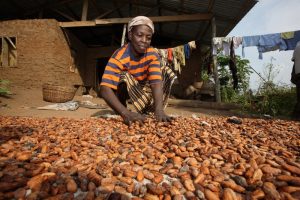Homemade chocolate
For chocolate:
- 60-70 g grated cocoa beans
- 30-40 g cocoa butter
honey to taste
Optional add-ons:
- salt, nuts, raisins, cinnamon
How to make homemade chocolate
1. Prepare the necessary ingredients.
2. Melt cocoa butter in a water bath, add cocoa beans, bring to complete dissolution of cocoa beans. Mix.
3. Add honey to taste (sugar can be used). Mix. And then add to your taste: nuts, raisins, cinnamon, vanilla, salt. I like the chocolate a bit salty, it’s like the one they sell – Special.
4. Pour hot chocolate into molds, do not grease the molds, and put in the refrigerator until it hardens. It is better to take plastic or silicone molds, it will be easier to remove the finished chocolate from them. You just need to slightly pull the edges of the form, freeing the chocolate, and carefully turn the form on a flat surface. The chocolate will fall out on its own.
5. Here is homemade homemade chocolate in three different flavors: salt, almond, and raisin.
All chocolate mood!

Raw cocoa beans are sun-dried grains of the fruits of the chocolate tree, from which cocoa powder, cocoa butter, cocoa mass are made. And from all of the above, real chocolate is made. 100% real!!!
This variety of cocoa beans is called “Forastero” (Forastero), the country of growth is Côte d’Ivoire, Africa.
Cocoa beans are quite large. They are oval, 2-2.3 cm long, 1-1.5 cm wide. Slightly flattened.
The taste differs from both cocoa powder and chocolate. The taste is tart and bitter, but rich and refreshing. It’s hard to describe in words. Need to try!
This is not a delicacy, you will not get aesthetic pleasure from chewing a cocoa bean. But they really satisfy the feeling of hunger and, most importantly, the desire to have something to eat.
If you eat cocoa beans every day, then your well-being improves, more energy appears, vitality and tone increase.
You decide to buy raw cocoa beans in an online store and the question is, “what to do with them next?” becomes especially relevant. For those who have decided to try real cocoa beans for the first time and have no experience with cocoa beans, we have a few recommendations.
First, some general information.
Raw cocoa beans, like many nuts or seeds, have a shell (cacao vella).
Its hard parchment well protects the fragile core from crushing and helps the cocoa bean last longer. Cacao walla (shell) is not usually eaten, in fact it is waste. But, many use the technology of waste-free production of cheap chocolate, cocoa powder, in which chocolate or cocoa powder consists of 15 percent or more of it. In a word, cocoa beans must be peeled before use.
The shell of the cocoa bean is hard and thin, and in most cases adheres to the core so tightly that it interferes with its rapid removal. But you should not try to clean the shell with your nails, at the risk of simply getting hurt, you can’t hit the cocoa beans with a hammer – in this case you will get a crushed core mixed with fragments. Let’s make cleaning cocoa beans quick and painless.
Method 1 (for raw foodists)
1. Put the cocoa beans in a container and fill them with water at room temperature. Let them soak for 20-30 minutes. Soon you will see that detachments have appeared on the shell – these are the membranes of the cocoa bean.
2. After 20 minutes, take out a few beans. If the shell has become soft and easily peels off from the core, then the beans are ready for cleaning.
3. Drain, rinse the beans and start cleaning them. Here you can use the dexterity of your fingers or with a regular knife.
Don’t worry if the cocoa beans get a little wet during the soaking process – this does not affect their taste in any way. Just dry them in an open container.
If you are not making chocolate, then feel free to use them without drying, i.e. a little damp.
Method 2 (tastier, but with heat treatment)
1. Place the cocoa beans in a frying pan or baking sheet and place on the stovetop or in the oven.
2. Reheat the beans for a while. When heated, the shell of the cocoa bean dries out, becoming brittle and brittle. Now it is easy to clean it with your hands, just rub the bob with your fingers. The shell will crack and break, but the cocoa bean itself will also become brittle and brittle.

For a more detailed description of the process of roasting cocoa beans, read our article.
This method has a significant drawback: cocoa beans cease to be raw, which means they lose the properties of a raw natural product.
But there are also advantages: as a result of roasting, not only the moisture content of cocoa beans decreases – from the initial 7 ± 1 to 2.6 ± 0.2%, but at the same time chemical reactions proceed intensively with the formation of very necessary and valuable aromatic substances. Roasted cocoa beans become more fragrant and brittle with a unique chocolate, bitter and sour taste. It’s like the difference in the taste of raw and roasted sunflower seeds or hazelnuts and others.
Heat treatment significantly reduces the risk of contamination of cocoa wells with pathogenic bacteria, which can occur during fermentation. In general, the process of harvesting, fermenting, drying and packaging raw cocoa beans in Africa is far from sterile, in a word, African.
Therefore, when buying raw cocoa beans, it is MANDATORY!!! either wash them or roast them. Do not give to small children in the hands, it is better to wash your hands after raw cocoa beans.
Features of an African product, better re… than not before. Let’s all be healthy!
For a more detailed description of the process of fermentation of cocoa beans, read our article.
Purified cocoa beans in this state can be stored for a long time without losing their qualities, however, we recommend roasting exactly the amount that you need per day. Roasted cocoa beans are hygroscopic, that is, they absorb moisture from the environment (they become damp).
Store cocoa beans in such a way as to provide access to air for cocoa beans, for example, in dense fabric bags or in a jar covered with gauze mesh, which is secured with an elastic band. In airtight jars, the beans may lose their flavor and begin to rot.
